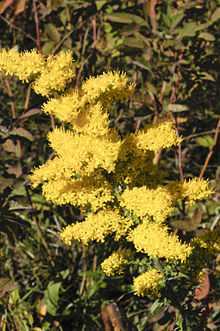Solidago nemoralis
| Solidago nemoralis | |
|---|---|
 | |
| Conservation status | |
| Scientific classification | |
| Kingdom: | Plantae |
| (unranked): | Angiosperms |
| (unranked): | Eudicots |
| (unranked): | Asterids |
| Order: | Asterales |
| Family: | Asteraceae |
| Genus: | Solidago |
| Species: | S. nemoralis |
| Binomial name | |
| Solidago nemoralis Aiton | |
Solidago nemoralis is a species of flowering plant in the aster family, Asteraceae. It is native to North America, where it is widely distributed in Canada except the northern provinces and the United States except the western states. Its common names include gray goldenrod, gray-stem goldenrod, old-field goldenrod,[1] field goldenrod,[2] prairie goldenrod, dwarf goldenrod,[3] and dyersweed goldenrod.[4]
Description
Like other goldenrods, this species is a perennial herb. One of the smaller goldenrods,[3] It grows 20 centimeters to one meter tall from a branching caudex. There are 1 to 6 erect stems, sometimes more.[5] The stems are reddish to gray-green and have lines of short, white hairs.[3] The lower leaves are up to 9.5 centimeters long and the blades are borne on winged petioles. Leaves on the upper half of the stem are narrower and shorter and lack petioles. The spreading inflorescence can carry up to 300 flower heads. The head contains 5 to 11 yellow ray florets each a few millimeters long and up to 10 yellow disc florets. Flowering occurs in late summer and fall.[5] The fruit is a rough-texured cypsela about 2 millimeters long tipped with a pappus of bristles slightly longer.[5]
There are two subspecies:[5]
- S. nemoralis ssp. decemflora – tetraploid taxon with larger flower heads and narrower basal leaves in west-central North America
- S. nemoralis ssp. nemoralis – diploid or tetraploid taxon in the eastern regions of the species' range
Ecology
This plant grows in forests, woods, prairies, grasslands, and disturbed areas such as old fields and roadsides.[5] It is a pioneer species and it can become weedy.[3]
The flowers have a variety of insect pollinators, including honey bees, carpenter bees, halictid bees, plasterer bees, sphecid wasps, vespid wasps, butterflies, moths, beetles, hoverflies, tachinid flies, flesh flies, blow flies, and muscid flies.[3]
Insects such as the goldenrod scarlet plant bug, leaf-footed bugs, and various caterpillars feed on the foliage. The American goldfinch feeds on the fruits.[3]
Uses
The plant had various uses among Native American peoples. The Houma people used it medicinally to treat jaundice. The Goshute used the seeds for food. The Navajo used it as incense.[4]
It is cultivated in landscaping and gardens, such as butterfly gardens.[3]
References
| Wikimedia Commons has media related to Solidago nemoralis. |
- ↑ Solidago nemoralis. Germplasm Resources Information Network (GRIN).
- ↑ Solidago nemoralis. NatureServe. 2012.
- ↑ 3.0 3.1 3.2 3.3 3.4 3.5 3.6 Belt, S. 2009. Plant Fact Sheet for gray goldenrod (Solidago nemoralis). USDA NRCS, Norman A. Berg National Plant Materials Center, Beltsville, MD. 2009.
- ↑ 4.0 4.1 Solidago nemoralis. Native American Ethnobotany. University of Michigan, Dearborn.
- ↑ 5.0 5.1 5.2 5.3 5.4 Solidago nemoralis. Flora of North America.
External links
- Solidago nemoralis. USDA PLANTS.
